高二英语下学期Unit 20
- 格式:doc
- 大小:21.75 KB
- 文档页数:2
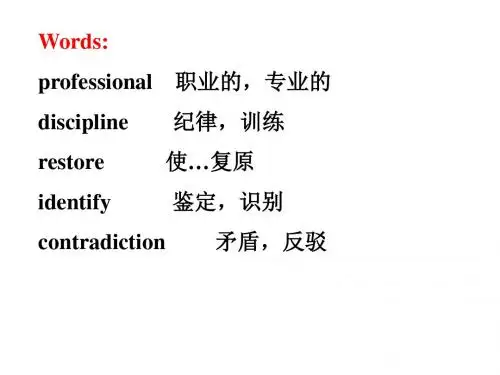
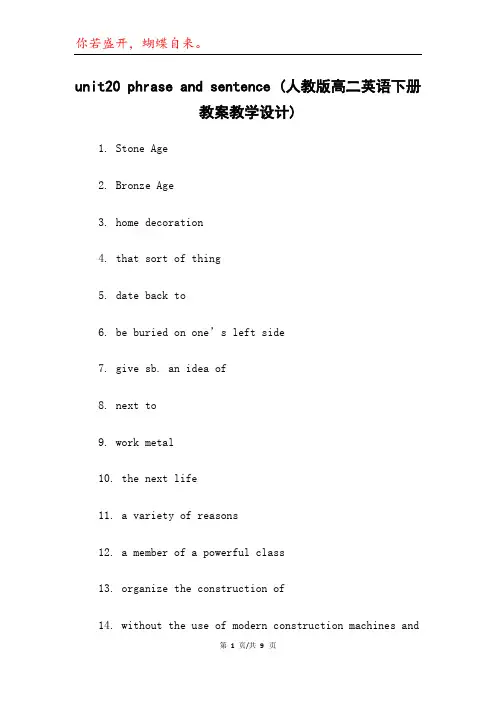
unit20 phrase and sentence (人教版高二英语下册教案教学设计)1. Stone Age2. Bronze Age3. home decoration4. that sort of thing5. date back to6. be buried on one’s left side7. give sb. an idea of8. next to9. work metal10. the next life11. a variety of reasons12. a member of a powerful class13. organize the construction of14. without the use of modern construction machines andlorries15. be linked to16. have a hand in17. Central Europe18. in terms of19. through war and armed conflict20. through trade and cultural links21. in the eyes of22. remote places23. have trade and cultural links with24. have knowledge about25. trade with26. construction workers27. close the site28. serve… for29. similar style30. dig up31. the Sanxingdui Ruins Site32. cultural relics33. make a poster34. be buried underground35. a historical city36. on the construction site37. build new underground lines38. cause a long delay39. national treasures40. by no means41. be concerned about1. 石器时代2. 铜器时代3. 家内装饰4. 那(这)一类的事情5. 回溯到, 远在...(年月)6. 向左侧身掩埋7. 使某人了解8. 紧邻的9. 加工金属10. 来世11. 很多理由12. 有权阶级中的一员13. 组织建筑…14. 不用现代化建筑机械和货车15. 与…有关16. 参加17. 中欧18. 就…而言19. 通过战斗和武装冲突20. 通过贸易和文化沟通21. 在...心目中22. 远方23. 与…有贸易和文化沟通24. 知道25. 与…进行交易26. 建筑工人27. 封锁现场28. 为…供应…29. 类似的风格30. 掘起, 挖出31. 三星堆遗址32. 文物33. 制作一张海报34. 被埋在地下35. 历史名城36. 在建筑工地37. 建筑新地铁38. 引起长时间耽搁39. 国宝40. 决不41. 关怀42. decorating materials43. have interest in44. a matter of education45. for nothing46. result in47. spread the basic knowledge among the population48. weigh…against…49. a professional discipline50. the field work51. treasure hunters52. follow the right procedures42. 装饰材料43. 对…有爱好44. 教育的问题45. 免费,徒劳46. 导致47. 向大众宣扬基本学问48. 把…看得比…更重要49. 特别专业的学科50. 野外工作51. 盗宝者52. 遵循正确的程序1. From tests on his teeth, it is certain that he spent his childhood in central Europe.2. Buried with him were the tools of a hunter or warrior.3. Close to his head were two pots made of clay, tools and materials to make arrows.4. Next to them lay a cushion stone, upon which the man could work metal.5. It was all that a person would need to survive-clothing, tools, weapons, pottery and spare materials to make new tools.6. It is possible that the King of Stonehenge was linked to the stones: he may have had a hand in planning the monument, or in helping transport and pull up the stones.7. In terms of technical development, people were going from the Stone Age to the Bronze Age.8. Iron came later, in what was called the Iron Age.9. At first it was thought that it was through war and armed conflict, but it is now believed to have happened through trade and cultural links.10. Thanks to modern technology, to find out more facts about the man buried in the grave is possible.11. For example, a gold mask and a bronze statue of a man remind visitors of the bronze masks and big bronze statues at Sanxingdui because of their similar style.12. In the spring of 1929, a farmer in today’s Nanxing Town,was working in the fields, when his son dug up a round piece of jade.13. It was four o’clock in the afternoon when he and his grandpa reached the museum in Guanghan, where an official warmly received them.文档内容到此结束,欢迎大家下载、修改、丰富并分享给更多有需要的人。
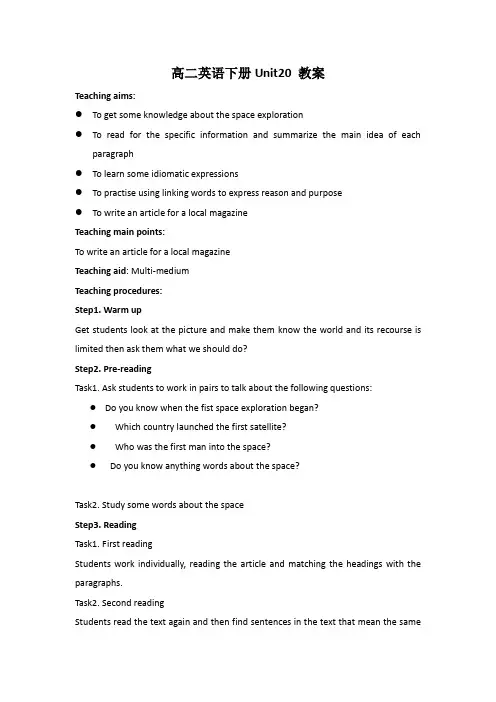
高二英语下册Unit20 教案Teaching aims:●To get some knowledge about the space exploration●To read for the specific information and summarize the main idea of eachparagraph●To learn some idiomatic expressions●To practise using linking words to express reason and purpose●To write an article for a local magazineTeaching main points:To write an article for a local magazineTeaching aid: Multi-mediumTeaching procedures:Step1. Warm upGet students look at the picture and make them know the world and its recourse is limited then ask them what we should do?Step2. Pre-readingTask1. Ask students to work in pairs to talk about the following questions: •Do you know when the fist space exploration began?•Which country launched the first satellite?•Who was the first man into the space?•Do you know anything words about the space?Task2. Study some words about the spaceStep3. ReadingTask1. First readingStudents work individually, reading the article and matching the headings with the paragraphs.Task2. Second readingStudents read the text again and then find sentences in the text that mean the sameas these colloquial sentencesDo the first item with the class firstStudents then complete the exercises working in pairsWhen check students’ answers, have individuals read out both sentences.Step4. ExerciseTask1. Get students work individually and match the words with the idiomatic expressions from the text (1-5) in italics.Task2. Using the following words to complete the sentences.Step5. WritingFirst, important elements in writingThen several choicesUseful vocabularyStep6. Homework。
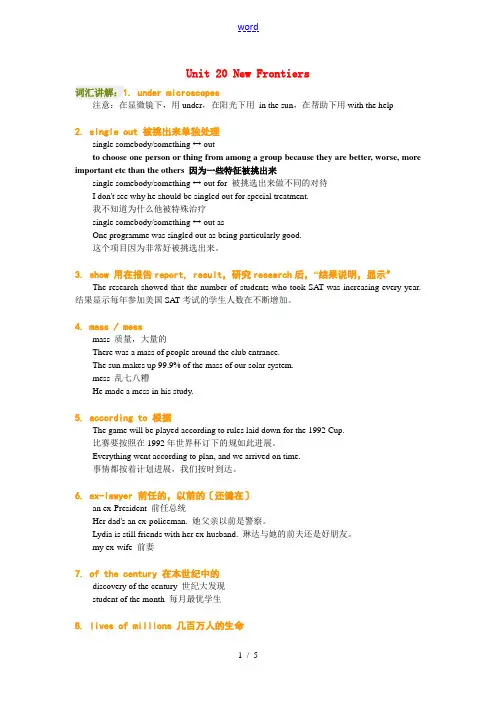
Unit 20 New Frontiers词汇讲解:1. under microscopes注意:在显微镜下,用under,在阳光下用in the sun,在帮助下用with the help2. single out 被挑出来单独处理single somebody/something ↔ outto choose one person or thing from among a group because they are better, worse, more important etc than the others 因为一些特征被挑出来single somebody/something ↔ out for 被挑选出来做不同的对待I don't see why he should be singled out for special treatment.我不知道为什么他被特殊治疗single somebody/something ↔ out asOne programme was singled out as being particularly good.这个项目因为非常好被挑选出来。
3. show 用在报告report, result,研究research后,“结果说明,显示〞The research showed that the number of students who took SAT was increasing every year. 结果显示每年参加美国SA T考试的学生人数在不断增加。
4. mass / messmass 质量,大量的There was a mass of people around the club entrance.The sun makes up 99.9% of the mass of our solar system.mess 乱七八糟He made a mess in his study.5. according to 根据The game will be played according to rules laid down for the 1992 Cup.比赛要按照在1992年世界杯订下的规如此进展。
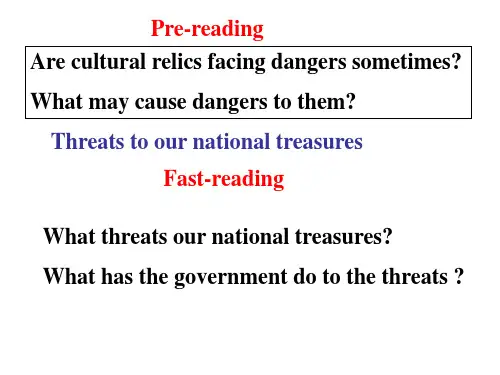
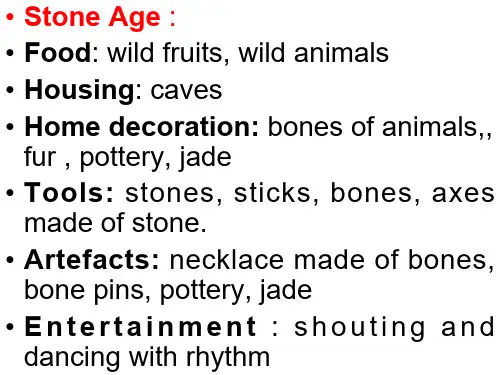
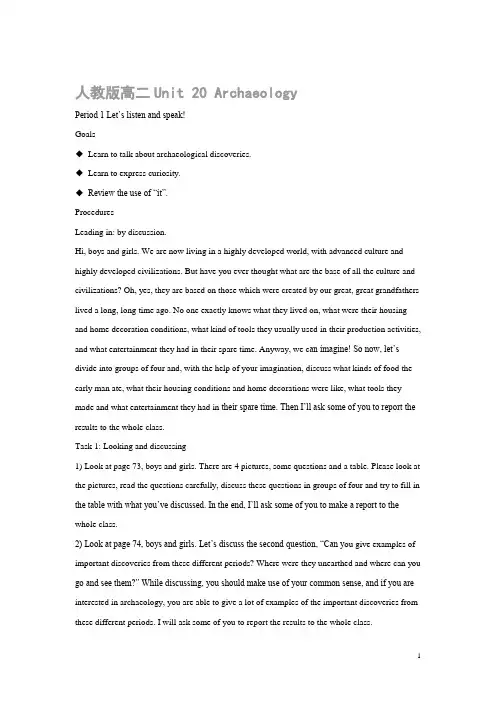
人教版高二Unit 20 ArchaeologyPeriod 1 Let’s listen and speak!Goals◆Learn to talk about archaeological discoveries.◆Learn to express curiosity.◆Review the use of “it”.ProceduresLeading in: by discussion.Hi, boys and girls. We are now living in a highly developed world, with advanced culture and highly developed civilizations. But have you ever thought what are the base of all the culture and civilizations? Oh, yes, they are based on those which were created by our great, great grandfathers lived a long, long time ago. No one exactly knows what they lived on, what were their housing and home decoration conditions, what kind of tools they usually used in their production activities, and what entertainment they had in their spare time. Anyway, we c an imagine! So now, let’s divide into groups of four and, with the help of your imagination, discuss what kinds of food the early man ate, what their housing conditions and home decorations were like, what tools they made and what entertainment they had in their spare time. Then I’ll ask some of you to report the results to the whole class.Task 1: Looking and discussing1) Look at page 73, boys and girls. There are 4 pictures, some questions and a table. Please look at the pictures, read the questions carefully, discuss these questions in groups of four and try to fill in the table with what you’ve discussed. In the end, I’ll ask some of you to make a report to the whole class.2) Look at page 74, boys and girls. Let’s discuss the second question, “Can y ou give examples of important discoveries from these different periods? Where were they unearthed and where can you go and see them?” While discussing, you should make use of your common sense, and if you are interested in archaeology, you are able to give a lot of examples of the important discoveries from these different periods. I will ask some of you to report the results to the whole class.Task 2: Listening, filling and speaking.1. Listen to the tape twice and fill in the blanks on page 74.2. First, the students should try to make a drawing of the tool according to the content of the tape; second, they should write down five of the questions asked by the students; third, they should answer the questions according to what they’ve heard; fourth, th ey should try to guess what else the object could be used for with the help of the drawing on page 74.Task 3: Speaking up.1) Work in pairs to make a dialogue. The purpose is to practice students’ speaking ability. Students A talks about a topic he or she likes, while Student B gives suggestions.Some useful topics for the students:Student A wants to know something about the prehistoric housing of the early man.Student B is interested in the food the prehistoric people had.Student C is eager to know the history of Sanxingdui ruins.Student D enjoys archaeological discoveries very much.Student E wants to have a clear idea of all the ancient archaeological sites both at home and abroad.Students F wants to know the development of agriculture in history.2) Work in pairs or small groups and talk about archaeological findings, such as artifacts, tombs or unearthed towns.Closing up by interviewing an archaeologist.Suppose that a famous archaeologist is giving you a talk about what archaeology is. He tells you that archaeology is the scientific study of peoples in the past, their culture and their relationship with their environment. The purpose of archaeology is to understand how humans in the past interacted with their environment, and to preserve this history for present and future learning. After listening to the talk, you want to ask him some questions about archaeology. These questions should include the contents above.HomeworkAsk the students to write a short passage about archaeology. They may write something about whether they are interested in archaeology, what they think of archaeology, how much they knowabout archaeology, or what they have learned from the text.Unit 20 Period 2 Let’s read!(THE KING OF STONEHENGE)Goals◆Learn to read for a general idea.◆Learn some useful words and expressions.ProceduresLeading in: by storyBoys and girls, now I’d like to tell you a story. In the spring of 2002, people in Britain pl anned to build a school at Amesbury in Wiltshire. While the workers dug the work site, they discovered something unusual, which led to the discovery of the grave of the King of Stonehenge. It is thought that this is a very important discovery in archaeology, because archaeologists discovered the richest Bronze Age burial in Britain. Do you want to know more about the discovery? Good. Now, I’ll give you five minutes for you to read the text and answer my question:Why is the discovery important?Task 1: Reading for the main idea.1. Read the text quickly and answer the following questions.①How many kinds of things were discovered in the grave of the King of Stonehenge?②What is the most important reason to describe the discovery as an important one?2. Read the text carefully and then decide whether the given statements are true or false.①On March. 3, 2002, archaeologists in England found a grave of a man dating back to around 3000 BC.②People got to know where the man was from by testing his bones.③From what were found in the grave people had a clear idea of the dressing of the King of Stonehenge when he was buried.④All the relics found in the grave of the King of Stonehenge were buried with him for his future use in the next life because of the belief that a dead man would come back to life.⑤The discovery of the King of Stonehenge was far from important.⑥The two earrings are not only the oldest gold ever found in England, but also a proof that the ancient British were clever enough to make gold even in around 2,500 BC.⑦Because of his power and his successful organization of the construction of Stonehenge, the man got his title as the King of Stonehenge.⑧In ancient times it was very difficult for the people then to construct the Stonehenge not because the stones were huge and heavy but because they couldn’t use our modern machines. Keys: ①F ②F ③T ④T ⑤F ⑥F ⑦T ⑧FTask 2: Reading and copying.Now it’s time to read the text again and copy down all the useful expressions.Useful expressions from the textdate back to around 2,300 BC, with his face to the north, a bone pin, carry… on one’s breast, gold earrings, be made of…, a second smaller copper knife, a cushion stone, work metal, a variety of reasons, tend to do sth., a member of a powerful class, the construction of Stonehenge, be linked to sth., have a hand in…, pull up, in terms of…, technical development, Stone Age, Iron Age, through trade and cultural links, the skills to make metal, be of high status, in the eyes of…, local peopleTask 3: Discussing and filling blanks.1. Now we are going to discuss the following questions in groups of four:①According to the text, the discovery of the grave of the King of Stonehenge is of great importance. Do you agree? Why or why not?②Archaeology is a scientific branch. Do you agree with this point of view? Why or why not? Can you give some examples to support your idea?2. Fill in the blanks according to the text>Finds ___________ Why important _____________ People’s opini on ___________(A possible key)Finds: clothing, tools, weapons, pottery, spare materials to make new toolsWhy important:1. richest ever found from that era;2. buried near Stonehenge site;3. having a hand in Stonehenge;4. making culture and technique exchange possible.People’s opinion:Thinking highly of what the King of Stonehenge had done.Closing up by interview.Finally we shall hold an interview with the chief archaeologist who was in charge of the excavation then. One of you will act as the archaeologist and others act as journalists, who are interviewing the archaeologist.HomeworkTry to find out some useful information about this part, write a short article on underwater archaeology.Unit 20 Period 3 Let’s study!(Grammar: Review the use of “It”)Goals◆Help the students to grasp some new words and improve the ability of defining words in English.◆Help the students to review the use of “it”.ProceduresLeading in: by listening.Hello, everyone! We learned THE KING OF S TONEHENGE yesterday. Now let’s listen to the tape of the text.(After listening to the text)Now I’ll ask you a question: Are you interested in archaeology? Do you want to be an archaeologist?Task 1: Defining words.1. Turn to page 77 and ask the students to do exercises of word study and fill in the blanks with proper words from the text.2. Explain the meaning and use of the words.3. Ask the students to make sentences with the words.Task 2: Studying Inversion.语法精讲It 的用法1、it 可指天气、温度、时间、距离等等-It is cold today, isn’t it? -Yes, isn’t it? -What’s the temperature? -It’s 26℃.-What’s the date today? -It’s May 1, 2005.-What’s the distance between the two towns? —It’s 10 miles.It’s a fine day. Let’s go f ishing, _________________? (全国高考90)A. won’t weB. will youC. can youD. shall we2、用作人称代词,代替前文提到过的事物The dog is not a cold-blooded animal. It doesn’t need to hibernate.3、为了避免重复,it可用来代替前面说过的短语或句子I tried to persuade my father to give up smoking, but found it impossible. (it = to persuade my father to give up smoking)He is a living Lei Feng and is always ready to help others. I know it clearly. (it = He is a living Lei Feng and is always ready to help others)4、代替指示代词this, that What’s this? It’s an album.Whose new bike is that? It’s Mary’s.【注意】it与one,that 的不同:it = the (that, this) + 名词,特指并且代替前面提到的某特定事物He’s bought a new car, so he drives it everywhere to show it off.There is only one piano left in the shop. I wonder if you still want to buy _________?A. itB. oneC. anotherD. anyone = a + 名词,one 指前面提到的同类事物中的不同的另一个0。
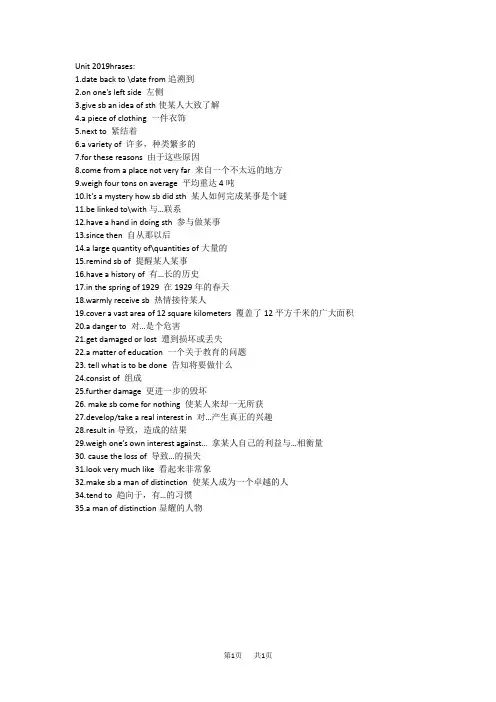
Unit 2019hrases:1.date back to \date from追溯到2.on one’s left side 左侧3.give sb an idea of sth使某人大致了解4.a piece of clothing 一件衣饰5.next to 紧结着6.a variety of 许多,种类繁多的7.for these reasons 由于这些原因e from a place not very far 来自一个不太远的地方9.weigh four tons on average 平均重达4吨10.It’s a mystery how sb did sth 某人如何完成某事是个谜11.be linked to\with与…联系12.have a hand in doing sth 参与做某事13.since then 自从那以后14.a large quantity of\quantities of大量的15.remind sb of 提醒某人某事16.have a history of 有…长的历史17.in the spring of 1929 在1929年的春天18.warmly receive sb 热情接待某人19.cover a vast area of 12 square kilometers 覆盖了12平方千米的广大面积20.a danger to 对…是个危害21.get damaged or lost 遭到损坏或丢失22.a matter of education 一个关于教育的问题23. tell what is to be done 告知将要做什么24.consist of 组成25.further damage 更进一步的毁坏26. make sb come for nothing 使某人来却一无所获27.develop/take a real interest in 对…产生真正的兴趣28.result in导致,造成的结果29.weigh one’s own interest against…拿某人自己的利益与…相衡量30. cause the loss of 导致…的损失31.look very much like 看起来非常象32.make sb a man of distinction 使某人成为一个卓越的人34.tend to 趋向于,有…的习惯35.a man of distinction显耀的人物第1页共1页。
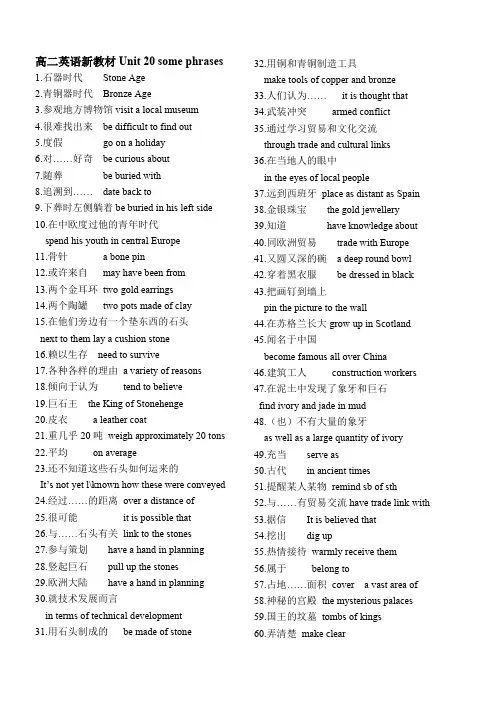
高二英语新教材Unit 20 some phrases1.石器时代Stone Age2.青铜器时代Bronze Age3.参观地方博物馆visit a local museum4.很难找出来be difficult to find out5.度假go on a holiday6.对……好奇be curious about7.随葬be buried with8.追溯到…… date back to9.下葬时左侧躺着be buried in his left side10.在中欧度过他的青年时代spend his youth in central Europe11.骨针 a bone pin12.或许来自may have been from13.两个金耳环two gold earrings14.两个陶罐two pots made of clay15.在他们旁边有一个垫东西的石头next to them lay a cushion stone16.赖以生存need to survive17.各种各样的理由a variety of reasons18.倾向于认为tend to believe19.巨石王the King of Stonehenge20.皮衣 a leather coat21.重几乎20吨weigh approximately 20 tons22.平均on average23.还不知道这些石头如何运来的It’s not yet l\known how these were conveyed24.经过……的距离over a distance of25.很可能it is possible that26.与……石头有关link to the stones27.参与策划have a hand in planning28.竖起巨石pull up the stones29.欧洲大陆have a hand in planning30.就技术发展而言in terms of technical development31.用石头制成的be made of stone 32.用铜和青铜制造工具make tools of copper and bronze33.人们认为…… it is thought that34.武装冲突armed conflict35.通过学习贸易和文化交流through trade and cultural links36.在当地人的眼中in the eyes of local people37.远到西班牙place as distant as Spain38.金银珠宝the gold jewellery39.知道have knowledge about40.同欧洲贸易trade with Europe41.又圆又深的碗 a deep round bowl42.穿着黑衣服be dressed in black43.把画钉到墙上pin the picture to the wall44.在苏格兰长大grow up in Scotland45.闻名于中国become famous all over China46.建筑工人construction workers47.在泥土中发现了象牙和巨石find ivory and jade in mud48.(也)不有大量的象牙as well as a large quantity of ivory49.充当serve as50.古代in ancient times51.提醒某人某物remind sb of sth52.与……有贸易交流have trade link with53.据信It is believed that54.挖出dig up55.热情接待warmly receive them56.属于belong to57.占地……面积cover a vast area of58.神秘的宫殿the mysterious palaces59.国王的坟墓tombs of kings60.弄清楚make clear。
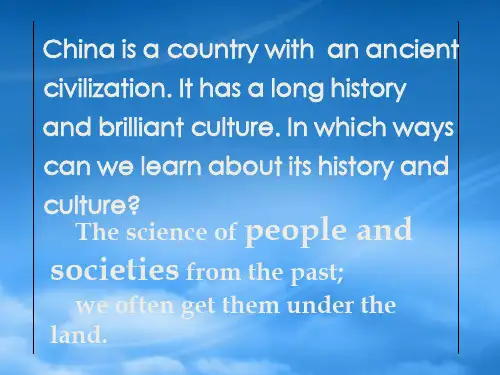
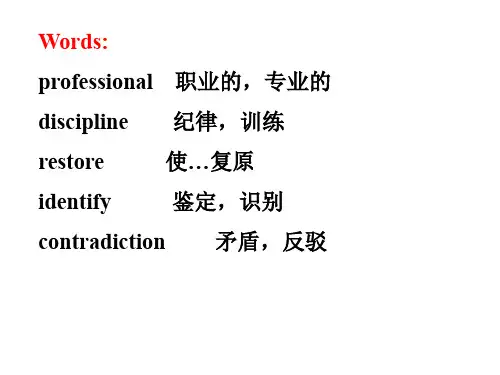
人教修订版英语高二下Unit2020rchaeology Reading教案
The King of Stonehenge
Teaching Aims:
1.To enlarge the students’ vocabulary in talking about archaeology and
historic events
2. Train the students’ reading ability.
3. Let the students learn about the King of the Stonehenge discovered by
archaeologists.
Teaching Important points:
1. Improve the students’ reading ability.
2. Help the students learn about the King of the Stonehenge by reading the
passage.
Teaching Difficult Points:
How to help the students understand the passage exactly.
Teaching Methods:
1. Discussion before reading to make the students interested in what they will
read.
2. Fast reading and careful reading to understand the passage correctly.
3. Pair or group work to make every student take an active part in the activities
in class.
Teaching Aids:
1. the multimedia
2. the blackboard
Teaching Procedures:
Step I Greetings
Greet the whole class as usual.
Step II Duty report
Step III Pre-reading
T: 1. Can you list some great emperors in Chinese history?
2. After kings and emperors died, what objects were buried with?
3. Why were dead kings given these objects after they died?
Step IV Reading
Show a picture of Stonehenge.
T: How much do you know about Stonehenge?
Have you heard of the king of Stonehenge?
Let’s read a passage about the mysterious Stonehenge and the King of Stonehenge. It must give you an unexpected surprise.
Task 1: 1.Scan the passage and write down which objects were found in the grave.
2. Describe the materials found in the grave.
Task 2: Go on to ask students to divide the passage into three parts and sum up the main idea of each part.
Later ask students to go through the whole passage quickly to find out correct answers to some questions.
Step V Listening
Listen to the tape. After listening, do the comprehension exercises.
Step VI Appreciation
Show some pictures of Stonehenge.
What do you think of Stonehenge?
Then draw a conclusion:
The construction of Stonehenge is a process of blood, sweat, and tears.
Step VII. Discussion
1. Why was the Stonehenge built or the purpose of the construction?
The main theories of the purpose existed and accepted in the world today:
Execution ground(刑场) Space station(宇宙太空港)Hunting ground(狩猎场)
An astronomical calendar(天文历法仪)Temple(宗教寺庙)
2. Suppose your hometown found an ancient grave, and some people suggest
digging it up, while others have different opinions. Please make up a dialogue with your partner, and express your idea.
Step VIII. Consolidation
Close your books, and finish the exercise on the screen. T or F exercises.
1. ( ) When the King of Stonehenge died, he was about 50 years old.
2. ( ) From tests on his teeth, it is certain that he spent his childhood in
England.
3. ( ) The most amazing find was two gold earrings.
4. ( ) Stonehenge was begun around 2300BC.
5. ( ) In terms of technical development, people were going from the Bronze
age to the Stone Age at that time.
6. ( ) It has been proven that the copper knives came from Spain and Western
France.
Step VIII. Homework
If you were the writer to introduce The King of Stonehenge, what story would you add to attract mor e readers? At last, don’t forget to prepare for the next period----language study. So much for today. Thank you!。